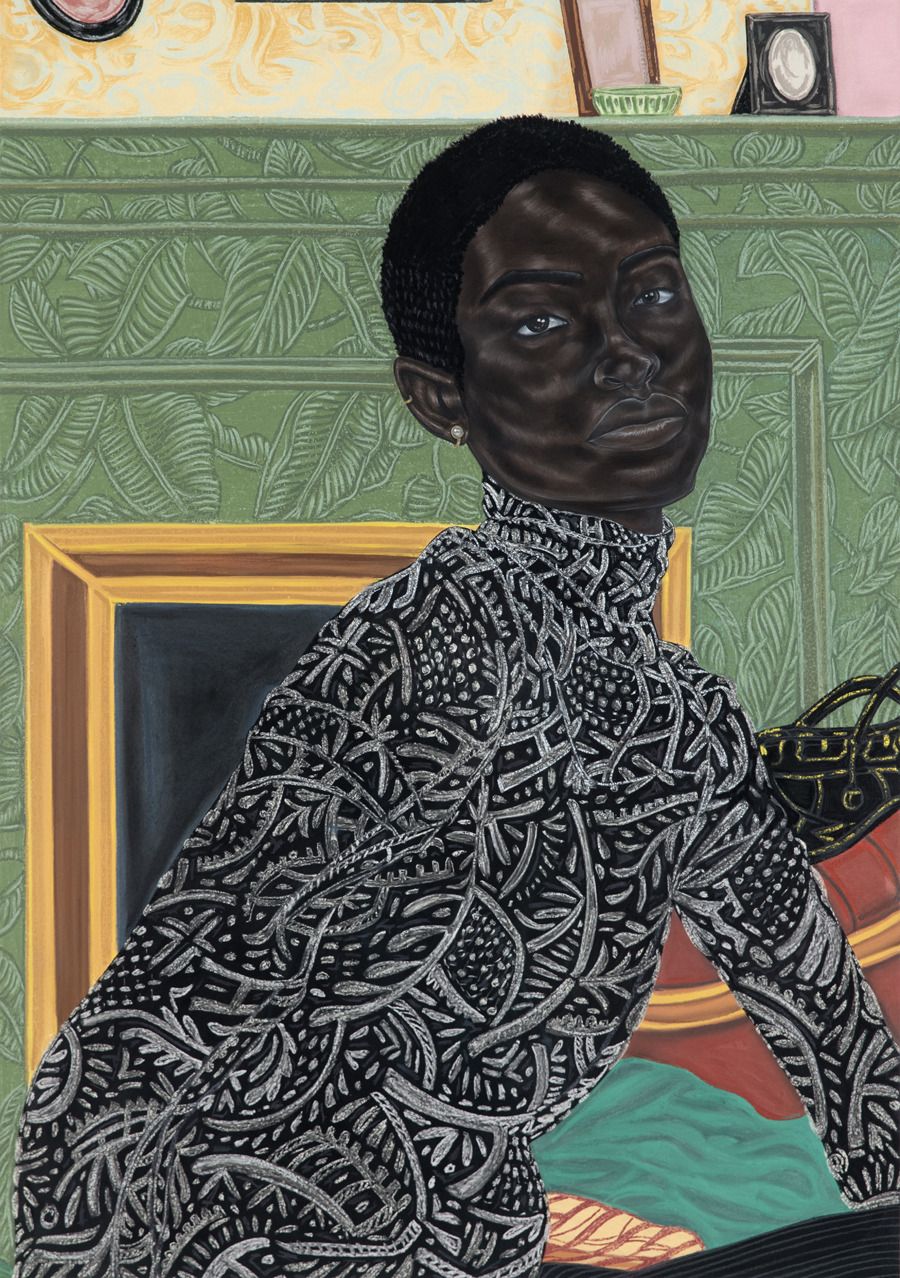
Toyin Ojih Odutola. Paris Apartment, 2016.
Charcoal, pastel and pencil on paper.
Though we are an aggregator blog (providing links to content elsewhere) on all other days, on Mondays we have only original writing by our editors and guest columnists. Each of us writes on any subject we wish, and the length of articles generally varies between 1000 and 2500 words. Our writers are free to express their own opinions and we do not censor them in any way. Sometimes we agree with them and sometimes we don’t.Below you will find links to all our past Monday columns, in alphabetical order by last name of the author. Within each columnist’s listing, the entries are mostly in reverse-chronological order (most recent first).
by Rafaël Newman
 Mourning is in season. Newspapers of record these days publish interactive mass obituaries, images of “ordinary” people fallen to “the opioid crisis” or to Covid-19 (the front page of the Sunday New York Times was recently riven down the middle by a monolith composed of thousands of dots, growing denser towards the base, each representing a victim of the virus: the whole reminiscent of the graphic tributes to 9/11). The inauguration of the US president in January featured, in lieu of most spectators, ranks of flags, symbolizing the past year’s losses. The annual observation of International Holocaust Remembrance Day in Germany, held this year as for the past quarter century on January 27 at the Reichstag in Berlin, featured a remarkable ceremony marrying reconciliation with the starkest grief. In his latest book, the memoir-cum-poetics Inside Story, Martin Amis eschews his characteristic charades in a sincere and extended eulogy for Saul Bellow, Philip Larkin, and Christopher Hitchens, three of the central figures in the author’s professional and affective life. And, 15 years after it first appeared, The Year of Magical Thinking, Joan Didion’s essay on death and bereavement, persists on various bestseller lists.
Mourning is in season. Newspapers of record these days publish interactive mass obituaries, images of “ordinary” people fallen to “the opioid crisis” or to Covid-19 (the front page of the Sunday New York Times was recently riven down the middle by a monolith composed of thousands of dots, growing denser towards the base, each representing a victim of the virus: the whole reminiscent of the graphic tributes to 9/11). The inauguration of the US president in January featured, in lieu of most spectators, ranks of flags, symbolizing the past year’s losses. The annual observation of International Holocaust Remembrance Day in Germany, held this year as for the past quarter century on January 27 at the Reichstag in Berlin, featured a remarkable ceremony marrying reconciliation with the starkest grief. In his latest book, the memoir-cum-poetics Inside Story, Martin Amis eschews his characteristic charades in a sincere and extended eulogy for Saul Bellow, Philip Larkin, and Christopher Hitchens, three of the central figures in the author’s professional and affective life. And, 15 years after it first appeared, The Year of Magical Thinking, Joan Didion’s essay on death and bereavement, persists on various bestseller lists.
Public commemoration of the dead famously deploys performative language – that is, it accomplishes what it sets out to do simply by its enunciation. Thus Pericles, in Thucydides’ reconstruction of his funeral oration during the Peloponnesian War, and Lincoln, in his Gettysburg Address, perform the unity of their respective “peoples” by eulogizing battle dead; while the institution of the cenotaph, the tomb of the Unknown Soldier, is such a central feature of the performance grammar of national identity that, according to Benedict Anderson, there is no need to specify the provenance of the particular “ghostly national imaginings” with which each discrete tomb is “saturated”. The grave itself has become an eloquent “speech act”. Read more »
by Jeroen Bouterse
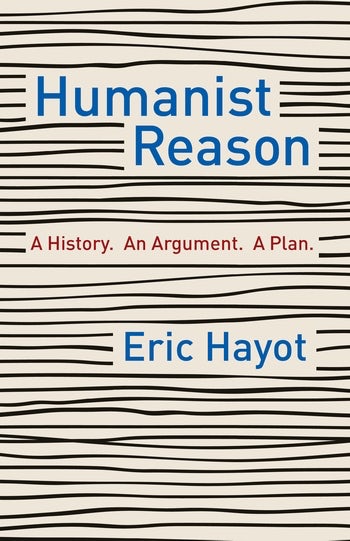 Unfortunately, it is always worth your time to read a book in praise of the humanities. Given the unenviable position of the humanities in public education and in contemporary cultural and (especially) political discourse about valuable expertise, any author that comes to their defense has to find a strategy to shift the narrative, and will thereby almost invariably do something interesting.
Unfortunately, it is always worth your time to read a book in praise of the humanities. Given the unenviable position of the humanities in public education and in contemporary cultural and (especially) political discourse about valuable expertise, any author that comes to their defense has to find a strategy to shift the narrative, and will thereby almost invariably do something interesting.
They move our focus from economic value to democracy and citizenship, for example. Or they argue that there is not actually a mismatch between the skills provided by a well-balanced liberal arts curriculum and the demands of technocapitalism, or that the humanities themselves produce the same kinds of intellectual goods as the natural sciences with which they tend to be contrasted.
These apologies are intellectually creative, though with luck some of them may grow to be new clichés. In their diversity, they also have something in common, which is that they project a rather straightforward view of the knowledge that the humanities and (other) sciences produce. One point on Martha Nussbaum’s agenda in Not For Profit, for instance, is to “teach real and true things about other groups”.
I feel slightly uneasy about this. Maybe this kind of book is not the place to get all difficult about the words “real and true”, but whenever elevator words like those are used with such confidence, part of me is inclined to get difficult about them – to look for the social and cultural interests that put them there, for instance. What is more, the place where I learned to ask those questions was during my history major; they seem to me to point to something that is particular about the humanities, something that gets lost in these defenses. Read more »
by Brooks Riley
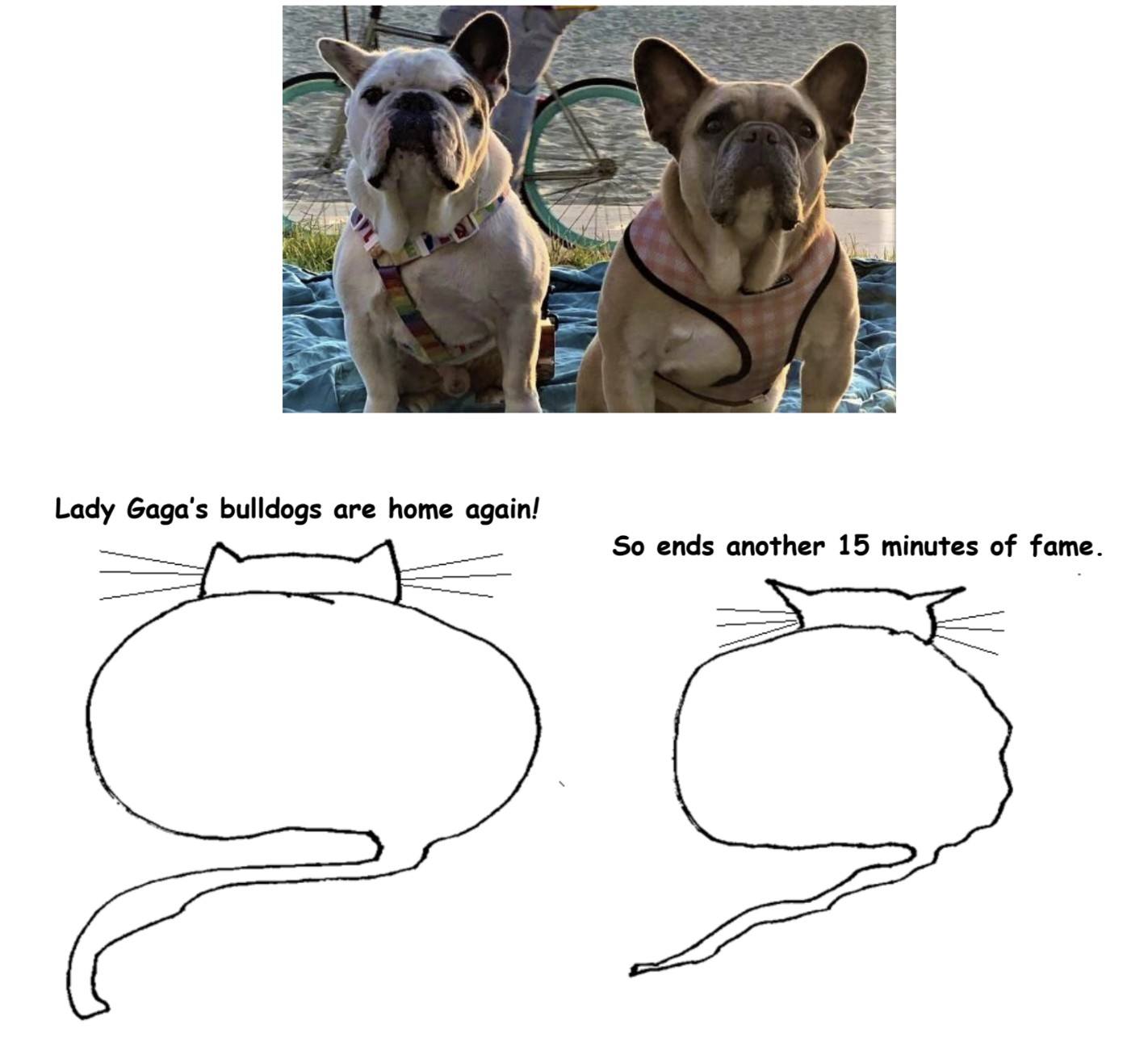
by Bill Murray
 Former Finnish President and Nobel laureate Martti Ahtisaari once gave a talk in our town and we went to see him. The distinguished gentleman who introduced him at Atlanta’s distinguished Piedmont Driving Club listed among Ahtisaari’s achievements “helping to achieve independence for Nambia.”
Former Finnish President and Nobel laureate Martti Ahtisaari once gave a talk in our town and we went to see him. The distinguished gentleman who introduced him at Atlanta’s distinguished Piedmont Driving Club listed among Ahtisaari’s achievements “helping to achieve independence for Nambia.”
We visited Nambia a few years back, and found that the locals actually call it “Namibia.” Its European colonizers called it Southwest Africa. Call it what you like, it’s one of the world’s really remarkable places. Unusual things happen in Namibia.
Most places, rivers flow to the sea. The thousand-mile long Okavango River flows into desert, beginning in the highlands of Angola where it’s called the Cubango. The Cubango becomes the Kavango as it marks the Angola/Namibia border. There it hits a fault line and spills into the Kalahari Desert in Botswana, where it is finally known as the Okavango.
It’s hard to visualize an inland delta, so consider its scientific definition; geographers call it an alluvial fan, depositing some two million tons of sand and silt every year and draining summer rain from a catchment area something like the size of Nepal or Tunisia.
This labyrinth of channels, islands and plains brings forth papyrus swamps, forests and savannah, providing habitats for elephant, lion, crocodile, hyena, leopard, zebra, cheetah, porcupine, monkey, serval, baboon, wild dog, hippo, giraffes, buffalo, wildebeest, kudu, warthog, impala, tsessebe and countless more. Read more »
by Sarah Firisen
 I just spent two months living on the Caribbean island of Grenada. It’s a wonderful place with a somewhat antiquated healthcare system. To visit Grenada, I had to have a negative PCR test within 72 hours of flying. I was planning to go to a clinic and wait in line, which I’d done for a previous PCR test. I’d waited in line in the freezing cold for almost 3 hours. But a couple of weeks before my flight in January, Jet Blue let me know that Grenada was accepting PCR tests through a company called Vault who would mail me an at-home test. I signed up, they sent me the test, and three days before my flight, I logged onto a Zoom call with Vault from the comfort of my own living room. My test kit had a barcode and I had to show that to the technician on the Zoom. She then watched me spit into the vial with the barcode and instructed me how to package up the kit appropriately to send it back. I walked it over to UPS 30 minutes later, and within 48 hours, I received my results by email.
I just spent two months living on the Caribbean island of Grenada. It’s a wonderful place with a somewhat antiquated healthcare system. To visit Grenada, I had to have a negative PCR test within 72 hours of flying. I was planning to go to a clinic and wait in line, which I’d done for a previous PCR test. I’d waited in line in the freezing cold for almost 3 hours. But a couple of weeks before my flight in January, Jet Blue let me know that Grenada was accepting PCR tests through a company called Vault who would mail me an at-home test. I signed up, they sent me the test, and three days before my flight, I logged onto a Zoom call with Vault from the comfort of my own living room. My test kit had a barcode and I had to show that to the technician on the Zoom. She then watched me spit into the vial with the barcode and instructed me how to package up the kit appropriately to send it back. I walked it over to UPS 30 minutes later, and within 48 hours, I received my results by email.
A couple of weeks ago, towards the end of my stay in Grenada, I started to get some awful shooting pains in my right leg. A few days later, I woke up to a horrible rash that was blistering. I went on WebMD and put in my symptoms. Looking at the possible diagnoses it suggested, I was reasonably sure that I had shingles. I was able to look at photos of a typical shingles rash that looked a lot like what was all over my thigh. I took a photo of my rash, went online to my health insurer, UnitedHealthcare, and requested a telehealth video call. Five minutes later, a doctor came online. I uploaded the photo of my rash, told her my symptoms, and said that I thought I had shingles. She immediately validated my WebMD diagnosis and prescribed a course of Valtrex, which I could get filled at a Grenadian pharmacy. Read more »
by Michael Liss
 The Machine has me in its tentacles. Some algorithm thinks I really want to buy classical sheet music, and it is not going to be discouraged. Another (or, perhaps it is the same) insists that now is the time to invest in toner cartridges, running shoes, dress shirts, and incredibly expensive real estate.
The Machine has me in its tentacles. Some algorithm thinks I really want to buy classical sheet music, and it is not going to be discouraged. Another (or, perhaps it is the same) insists that now is the time to invest in toner cartridges, running shoes, dress shirts, and incredibly expensive real estate.
Swinging over to the relative peace and quiet of my email box, I find an extraordinary number of politicians bidding against one another for my attention. It’s a little like Christmas come early: “Now, Stringer, now, Helen, now Andrew and Adams! On, Williams on, Loree! on, Kallos and Weprin!” Every single one of them vibrates with intensity, assuring me that he or she is ready to serve me, my family, my community, and the world. Oh, and, by the way, brother, can I spare a dime?
I need my dimes right now. I’m not moving to a deluxe apartment in the sky, and I’ll buy more dress shirts when the world gets back to normal and I ditch this pandemic-related beard. So, back to Schirmer’s Selected Piano Masterpieces (Intermediate Level). I know my sin. My daughter and I were talking about the accompaniment in Schubert’s Lieder and I (foolishly, without going into a private viewing mode) did a quick search. This was more than two weeks ago, and The Machine will keep at me until it is convinced I absolutely, positively, won’t give in. Machine, if you are reading (and I know you must be), please trust me, I can’t play the piano, and I definitely can’t sing. I’d be happy to post something to YouTube to prove it. Or ask my friends to confirm—after all, you know who they are. Read more »
by Akim Reinhardt
 Two profound horrors have plagued the world in recent times: the Covid-19 pandemic and the Trump presidency. And after years of dread, their recent decline has brought me a brief respite of peace.
Two profound horrors have plagued the world in recent times: the Covid-19 pandemic and the Trump presidency. And after years of dread, their recent decline has brought me a brief respite of peace.
Not that my peace was ever disturbed as much as many others’. One reason is that unlike the ICU patient or the undocumented immigrant child, neither horror has ever afflicted or assailed me directly. Another is that I have long been comfortable with impermanence, the reality that nothing lasts forever. Not the United States. Not me. Should the one be toppled by a dictatorial demagog or the other felled by a microscopic, multiplying coronavirus, so be it. All must end eventually.
Yet here we are, steps closer to but still somewhere short of the Great Undoing that the pathogen and the politician relentlessly dragged us towards. And only now, as their grips finally begin to release a bit, can I recognize more fully how each, in its own way, had previously commanded my attention, either undermining my peace or at least forcing me to redefine it.
First, the blinding orange glow.
Just the other day it dawned on me that not only hadn’t I thought about Donald Trump for a couple of weeks, but I also had not spent much energy charting the republic’s precipitous decline and decay. That is not to say I see Joe Biden as some kind of savior, or even have high expectations for his administration. I don’t. Nor am I convinced that the world is better off with the United States than without it. There are strong arguments either way. But regardless, to live in the United States during the Trump presidency, and to recognize the very real threat it posed to American culture and to U.S. constitutional systems and democratic and institutions, meant that you had to, at the very least, pay close attention to their ongoing perversion and erosion. Because it’s one thing to be intellectually okay with the United States’ eventual demise. It’s another to live through various stages of it while facing down the very real prospect of increased oligarchy, theocracy, nativism, and racism. Read more »
by Philip Graham
 Whenever I discover a band that sports an accordion in the lineup, I’m ready to listen.
Whenever I discover a band that sports an accordion in the lineup, I’m ready to listen.
But this wasn’t always so.
It all goes back to the mid-1960s, those days of my mid-adolescence, when my father’s favorite cousin, who we called our “aunt” May, came to visit nearly every weekend. The year before, her hard-drinking brother’s liver had finally given up on him, and my father wanted to draw her closer to our family. Aunt May lived alone, unmarried and childless. As if this was a condition that needed explanation, our parents whispered to us a secret we were never to repeat aloud, that she once had a boyfriend, but he’d died in World War II and she never found another man like him.
After the ritual of a Saturday afternoon dinner, the time arrived for the ritual of settling in the living room to watch the latest installment of Aunt May’s favorite program, Lawrence Welk’s musical variety show. My younger brother and I were expected to keep her company. We, too, loved our kind and self-effacing aunt, but to my easily-affronted adolescent self, Lawrence Welk had invented his show to personally torment me. It was a kind of musical quicksand, Stepford Wives music, everything that rock and roll was trying to replace or destroy. Read more »
You may or may not know that sukiyaki is a beef-based Japanese hot-pot dish. But I’m not talking about food. I’m talking about music, specifically, a Japanese pop song entitled “Ue o Muite Arukō” (“I Look Up as I Walk”) which was a hit by Kyu Sakamoto in 1961 in Japan, 18 years before Hiromi Uehara was born. It became one of the world’s best selling singles of all time (13 million copies) and has been recorded countless times by singers all over the world. [Various versions on YouTube.] It was issued in the United States in 1963 as “Sukiyaki”, where it went to the top of the Billboard Hot 100.
Why “Sukiyaki”? Perhaps, you’re thinking, it’s a novelty song about the dish? No, it’s not. It has nothing to do with food. According to Wikipedia:
The lyrics tell the story of a man who looks up and whistles while he is walking so that his tears will not fall, with the verses describing his memories and feelings. [Lyricist Rokusuke] Ei wrote the lyrics while walking home from a Japanese student protest against the Treaty of Mutual Cooperation and Security Between the United States and Japan, expressing his frustration and dejection at the failed efforts. However, the lyrics were purposefully generic so that they might refer to any lost love.
The melody is wistful and haunting. I would imagine that is what propelled the song to international fame. Many of the cover versions use different lyrics. As for the renaming in America, it’s about marketing. “Sukiyaki” is a Japanese word that Americans would recognize as Japanese.
Here’s the original version:
Notice the whistled sections – appropriate to the origin story, which I remember from my childhood. Read more »
by David Oates
 An empty space sits where I once sat. I miss it. I miss the strangers I shared it with, and a few regulars with whom I achieved a nodding relationship. A couple of baristas I might greet and chat up. Very briefly.
An empty space sits where I once sat. I miss it. I miss the strangers I shared it with, and a few regulars with whom I achieved a nodding relationship. A couple of baristas I might greet and chat up. Very briefly.
I miss the space itself – long and wide, its tall ceiling held up by industrial concrete pillars of old-fashioned ornateness reflecting its Model-T era use as a Ford manufactory. The space gave room to think and to be connected yet anonymous, with big tables for groups and – the star attraction for me – counter tables all along the windows where for years I have sat for my afternoon writing and reading. Getting lost in a poem or a book. Jotting a few words experimentally, or working on a chapter in progress. Gazing idly at someone at a sidewalk table (peeking at a book title if I can see it). Taking in the rush of cars and trucks, heading towards their 4:30 gridlock.
Strangers walk by with dogs, or with addictions, or with clothes nicer than I even know the words for. They all make me think. . . of what? Hard to say. How much I like a kind face, or a handsome one. Or an old one with lines.
What unknowabilities we all are.
But this space now sits plague-emptied, closed down apparently permanently. Here I wrote large pieces of my last book. And the one before it. I relied on this perfect one-mile walk from my home, an afternoon leg-stretch, a change of scenery, a change of mind. A way to feel connected to the humans. (But not too connected.)
This sociable, urbane space was a bit of what is called the “New Urbanism,” a thing for which Portland, Oregon had become renowned. But New Urbanism is shut down now. Public spaces empty. Restaurants shuttered. Transit deserted.
As if all that was left us was to revert to the 1950s and move back to the suburbs, isolated and safe, bourgie and dull. For the plague, we fear, may be killing cities as well as individuals. Read more »
by Jonathan Kujawa
A striking aspect of math is its ability to stimulate both our minds and our humanity. We saw this already in our discussion of Francis Su’s book, the Mathematics of Human Flourishing. As he explains more eloquently than I ever could, mathematics belongs with music, poetry, art, and nature in its ability to lift us up from the everyday mundane. Rather recently I learned of a perfect example I thought the readers of 3QD would appreciate. It’s a story that involves both neat mathematics and beautiful humanity.

The topic of the paper is continued fractions. As everyone knows, even if they’ve forgotten, we usually use write numbers using sums. For example, 327 is really shorthand for 300 + 20 + 7. And 0.327 is really shorthand for 3/10 + 2/100 + 7/1000. Of course, to capture all the numbers we are interested in using, we have to allow for infinite sums, even if that is sometimes a dangerous thing to do. For example, when we write
√2 = 1.41421356237…,
this is really a shorthand for
√2 = 1 + 4/10 + 1/100 + 4/1000 + 2/10000 + 1/1000000 + ….
But there is nothing sacrosanct about using repeated sums. We can also use repeated divisions. Once again you need to allow for infinitely many divisions to capture all the numbers we’d like to consider [1]. For example,
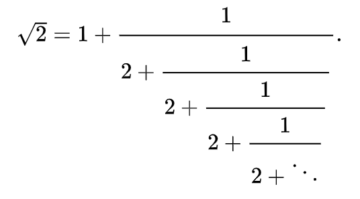
Like with sums, we’ve devised a more compact way of writing such continued fractions. Since we can always arrange so that the number above the division bar is a one, we can save ourselves work by only recording the number in front of the addition sign that appear at each level of the fraction. In this case, we would write [1, 2, 2, 2, 2, 2, …] for √2. Read more »
if I’d broken the laws of light—
if I’d been arrested by a black hole
and sent to prism,
would you still visit with spectral frequency
and split waves with me?
would you help cleave white
into colors and set them free
to carom off everything in sight
replacing the gates of hate
with rainbows?
Jim Culleny
5/8/18
Art installation by Hou De Sousa
by Chris Horner
I won that election —Donald J Trump
The truth is out there —X files
 There is a story that Clemenceau, the Prime Minister of France, was in conversation with some German representatives during the Paris peace negations in 1919 that led to the Treaty of Versailles. One of the Germans said something to the effect that in a hundred years time historians would wonder what had really been the cause of the Great War and who had been really responsible. Clemenceau, so the story goes, retorted that one thing was certain: ‘the historians will not say that Belgium invaded Germany’.
There is a story that Clemenceau, the Prime Minister of France, was in conversation with some German representatives during the Paris peace negations in 1919 that led to the Treaty of Versailles. One of the Germans said something to the effect that in a hundred years time historians would wonder what had really been the cause of the Great War and who had been really responsible. Clemenceau, so the story goes, retorted that one thing was certain: ‘the historians will not say that Belgium invaded Germany’.
The anecdote repays some reflection. On the one hand, its main point seems clear: the brute fact that it was Germany that invaded Belgium and not the other way around cannot be wished away by later historians, whatever else they may say. Clemenceau, of course, is pointing to this as the evidence for the German responsibility for starting the war. On the other hand, the German representative also seems to be right: historians have been discussing the causes and the responsibility for World War One ever since 1914, and show no signs of concluding. The assessment of an event like that depends on interpretation and the sifting of evidence. It isn’t just a matter of pointing what happened on an August day in 1914. Yet some things remain stubbornly the case, we think: German troops violated Belgian neutrality in 1914.
In a hundred years time will historians wonder who won the US Presidential Election of 2020? Perhaps not, but the world we live in seems to be one in which the most ‘stubborn’ facts are in question. Much of the confusion can be wrought by bad faith actors, people who know they are lying when they claim certain things to be true. These bad faith actors aren’t just figures from the margins of the political spectrum, or among the deluded ‘QAnon’ conspiracy enthusiasts. In our time we have seen the US and UK governments, supported by the bulk of the established media outlets repeat falsehoods about the possession of WMDs in Iraq, to give just one example. No wonder there is a lot of ‘fake news’ when so much of it is generated by government itself. Read more »
by Brooks Riley
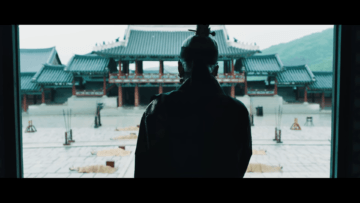 We are not where we were one year ago—or have we just returned?
We are not where we were one year ago—or have we just returned?
This is the paradox of the pandemic: Lockdown has sent many of us on the wildest of journeys—not to a different place, but to a different self, even if such a destination is temporary.
What if a consequence of going nowhere and doing nothing for a year is finding out there’s a stranger living inside you? Unlike yourself these days, the stranger isn’t in isolation. It goes everywhere you can’t, especially down rabbit holes where the ‘you’ you think you know would never go. Uninvited, this stranger is no guest, it’s just been squatting in your brain until the time was right.
Don’t confuse the stranger with an inner voice. The stranger doesn’t chat or chatter. It’s not interested in your opinions, nor does it want to convince you of something, or help you ‘harness’ an inner anything. Its agenda is to hold you hostage, no questions taken, no answers given.
I’m unclear as to the stranger’s gender. Is it a girl, a middle-aged man, a woman, an old lady, a boy? Does it matter now that the stranger lives in the part of yourself that once indulged in its own peregrinations?
When you weren’t looking, it pulled up a chair next to you and grabbed the mouse, that most direct instrument of intent, and began to map out a new itinerary. It’s become harder not to notice as it steers your ship of self away from its charted course and into unknown territory. An interloper in your command central, the stranger now begins to assert itself, to exert its will in appalling ways–mostly having to do with music. Read more »
by David Kordahl
 In the part of my life when I was most actively trying to invent myself as a writer, I was working as a high school teacher and was desperately unhappy. (Notice the way that I put this: “I was working as a high school teacher,” not “I was a high school teacher”; the notion that a job defines a person still disgusts me.) In the evenings, I left work and wrote magazine pitches, not as many, I realize in retrospect, as could have brought me success, but enough to keep me talkative in the teacher’s lounge. I had the impression, back then, that a writer could make a name for himself on the basis of a single strong piece, and since my work was deeply derivative—I was, after all, inexperienced—I hatched a plan.
In the part of my life when I was most actively trying to invent myself as a writer, I was working as a high school teacher and was desperately unhappy. (Notice the way that I put this: “I was working as a high school teacher,” not “I was a high school teacher”; the notion that a job defines a person still disgusts me.) In the evenings, I left work and wrote magazine pitches, not as many, I realize in retrospect, as could have brought me success, but enough to keep me talkative in the teacher’s lounge. I had the impression, back then, that a writer could make a name for himself on the basis of a single strong piece, and since my work was deeply derivative—I was, after all, inexperienced—I hatched a plan.
Some of my favorite writers, from Tom Wolfe to Hunter S. Thompson to David Foster Wallace (I know, go on, roast me), had visited Las Vegas to mine its filth for gold. I figured that I could do the same. No one responded to my pitch (why would they), but I was undeterred. I bought a plane ticket to Las Vegas to write a piece so great it would be undeniable, an X-ray of American culture.
The site I chose for my con was the Consumer Electronics Show, the 2014 International CES. This required a bit of planning, since CES was (and is) an officially closed event, whose guidelines only allow industry insiders to attend—writers, for instance, whose venues reach “more than 1,000 unique monthly visitors and [are] updated weekly with original tech-industry related news.” I was no professional, but I listed myself as writing for an online book review, which was sort of true. After an initial rejection, CES (mistakenly?) gave me a press pass, which I took as a good omen.
The piece that I wrote about this event, all 13,000 words of it, was never published, but I reread it recently and was surprised. The world (to repeat a cliché) seems to have experienced a schism in the past decade, but such schisms aren’t so easy tracked in oneself.
My piece used the appearance of convention-goers wearing the Google Glass, that relic of wearable tech, as an organizing motif. In January 2014 this seemed futuristic (a commercial version wouldn’t be released until March), a symbol of the cyborg world to come.
I could hardly have been less prescient. Read more »
by Brooks Riley
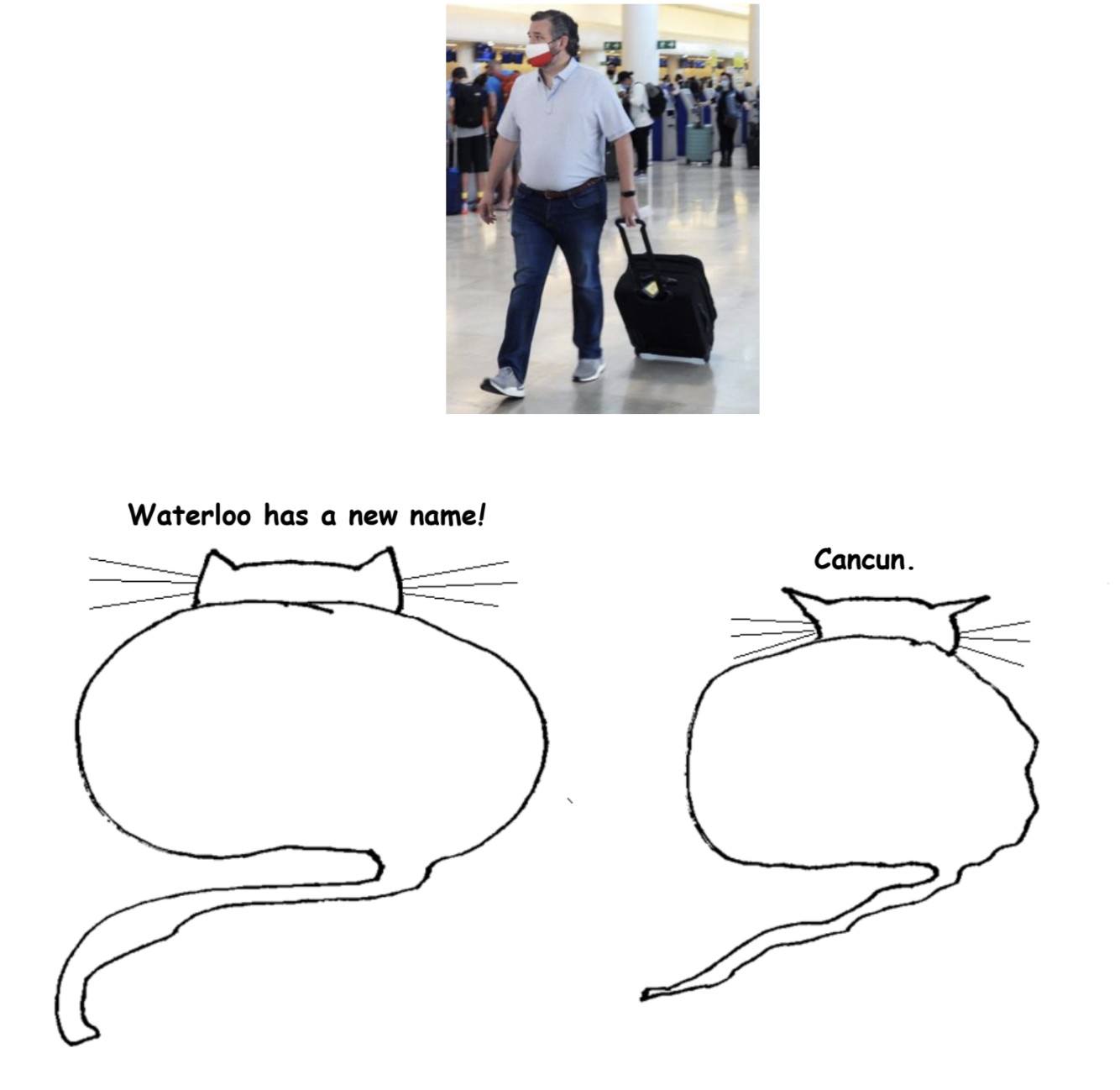
by Tim Sommers

A libertarian. Old joke. I mean, marijuana is not even illegal in a lot of states anymore. How about this one? A libertarian walks into a bear. Okay, that’s not really a joke. It’s the title of a recent book by Matthew Honogoltz-Hetling, subtitled “The Utopian Plot to Liberate an American Town (And Some Bears)”. It’s about a group of libertarians who move to a rural town with the express purpose of dismantling the local government and producing a libertarian utopia. The resulting problems with coordinating refuse disposal attract a lot of bears and the lack of a government makes it difficult to mount a response. Bears 1. Libertarians 0.
I have been thinking about libertarianism again since I read Thomas Wells’ smart 3 Quarks Daily article Libertarianism is Bankrupt arguing that libertarianism, “like Marxism or Flat-Earthism”, has “nothing to offer”. Which is kind of unfair to Marxism if you ask me. But a real-world example of how dead the libertarian horse is, is offered by the departure of many recovering libertarians from the Cato Institute recently, the bulk of them forming a new non-libertarian think tank (Nikensas). What lead most of these former Cato staffers to abandon libertarianism was the existence of a political problem that they felt libertarianism had no response to. I bet you can guess what it is. (I’ll tell you at the end, just in case.)
In the meantime, given the moribund state of libertarianism, rather than beat on it some more, I thought it would be fun to return to its glory days, to Robert Nozick and his book Anarchy, State, and Utopia. Nozick was arguably the most philosophically sophisticated libertarian ever. He was charismatic. He was purportedly widely read in the Reagan White House. And he was lauded as one of the Philosopher Kings of Harvard by Esquire Magazine in 1983 (including a full-page photospread in which he looked very thoughtful). (The other Philosopher-King, John Rawls, refused to be interviewed or photographed for the piece.) Read more »